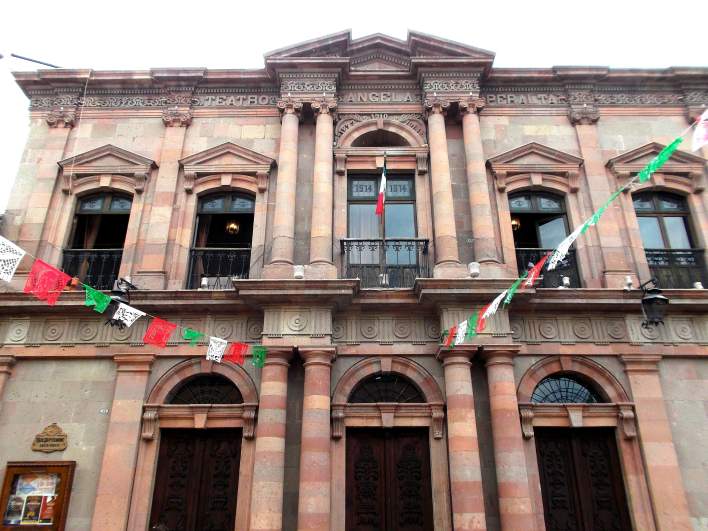
Library of Congress Ángela Peralta was a Mexican opera singer.
Ángela Peralta was a Mexican opera singer. Peralta is being celebrated with a Google Doodle on July 6, 2021, on what would have been her 175th birthday. Peralta died in 1883 at the age of 38.
“Today’s Doodle celebrates the 175th birthday of Mexican pianist, harpist, composer, and internationally-renowned operatic soprano Ángela Peralta, who is widely considered one of the most significant Mexican opera singers of her era,” Google wrote on its Doodle blog. “Happy birthday, Ángela Peralta. Here’s to all those performances that ended on a high note!”
Here’s what you need to know about Ángela Peralta:
1. Peralta Was Born July 6, 1845, in Mexico City

GoogleGoogle is paying tribute to Mexican opera singer Angela Peralta.
Peralta was born July 6, 1845, in Mexico City, Mexico. According to InfoBae, Peralta was the daughter of an educator and soldier. She was born in the Las Vizcainas neighborhood of Mexico City, according to the news website.
Peralta showed a gift for singing from an early age and trained with a music tutor when she was a child, according to her biography on Encyclopedia.com. According to Relatos e Historias en Mexico, Peralta was known for her “expressive timbre of her voice and the sounds it reached.”
According to the Google Doodle blog about Peralta, “Her reputation as a remarkable singer began to take hold with her solo performance of a cavatina from the Italian opera ‘Belisario’ at just 8 years old.” El Univeral wrote in 2008 that Peralta was of “humble origin” but received a good education from a young age because of her singing talent and “extraordinary voice.”
2. Peralta Debuted at One of Mexico’s Premier Opera Houses When She Was 15 & Her Performance Led Her to Move to Italy to Train
Google writes about Peralta, “At 15, Peralta made her operatic debut at the Gran Teatro Nacional—one of 19th-century Mexico’s premier opera houses. This performance received such acclaim that it prompted Peralta to further refine her talent in Italy, the birthplace of opera.” According to El Universal, Peralta’s father found a donor named Santiago de la Vega to cover her expenses because of her talent.
According to Encyclopedia.com, Peralta is said to have impressed the German soprano Henrietta Sontag during a performance in 1854. Peralta trained at the National Conservatory of Music in Mexico.
History Today wrote in 2020, “In addition to singing, she was an accomplished harpist and composed numerous romantic pieces, including gallops, dances, fantasies, and waltzes.”
According to a review in a Mexican newspaper cited by Opera in Contention: Social Conflict in Late Nineteenth-Century Mexico City, “Mrs. Peralta, as always, enthused the audience, and the excitement reached its climax when Angela sang the aria of delirium. Our Nightingale becomes more deserving of her fame she has achieved every day, and the Mexican public considers her their most-loved artist…An immense number of wreaths were thrown on the stage, and this artist received as tribute the most enthusiastic bravos and most deserved applause.”
3. Peralta Was Known as the ‘Mexican Nightingale’ & Toured Across Europe & the United States
As a teenager, Peralta toured across Europe with performances in Milan, Turin, Lisbon, Alexandria, Genoa, Naples, Saint Petersburg, Madrid and Barcelona, according to El Universal.
“In Milan, Peralta’s 1862 performance of the romantic opera ‘Lucia di Lammermoor’ so impressed the audience that standing ovations brought her back to the stage 23 times! The scope of her international tours broadened to include some of Europe’s most prestigious opera houses as well as the U.S., garnering the title of ‘Mexican Nightingale’ for her mastery of the lyrical operatic style known as bel canto,” according to the Google Doodle blog.
She returned to North America in 1865 at the age of 20 and performed in Havana, Cuba, and in the United States, according to El Universal. She also spent time performing in her native Mexico, including singing for emperor Maximiliano and empress Carlota in 1866, El Universal wrote.
According to Encyclopedia.com, “The decade 1865–1875 was the period of Peralta’s greatest activity. She toured Mexico and Europe, with performances in Havana and New York. A celebrated season followed her homecoming in 1871, because she brought with her the famous tenor Enrico Tamberlick and sang with him in another Mexican opera, Guatimotzín, by Aniceto Ortega del Villar. She formed her own opera company and acted as the impresario. Although best known for her bel canto singing, Peralta adopted a more dramatic style when she played the lead in her company’s first Mexican production of Verdi’s Aida, a role closely identified with her. Another facet of her later career was composition of popular songs.”
4. Peralta Eventually Returned to Mexico & Founded Her Own Troupe
Peralta would return to Mexico a second time in 1871 and performed again at the Gran Teatro Nacional, according to the Google Doodle blog. She then began her own touring troupe in Mexico.
According to Atlas Obscura, Peralta had an affair with her manager, Julián Montiel y Duarte, in the 1870s, after the death of her husband, Eugenio Castera. The site wrote that her “early fame was curtailed” by that affair.
“The relationship followed Peralta’s ill-fated marriage to her cousin who died in a Paris mental institution around the same time. Peralta and her manager’s new relationship so enraged the religious citizens in Peralta’s birthplace of Mexico City that the so-called ‘Mexican Nightingale’ was soon confronted by hired hecklers and faced boycotts of her performances altogether,” Atlas Obscura wrote.
5. Peralta Died August 30, 1883, in a Yellow Fever Epidemic

Gabriela Lozano/Wikimedia CommonsThe Angela Peralta Theater in Mexico is named in her honor.
Peralta died on August 30, 1883, in Mazatlán at the age of 38. She died after contracting yellow fever during an epidemic that had hit the region. According to Atlas Obscura, “Despite setbacks and vowing never to play Mexico City again (a vow she tragically kept), Peralta’s talent ensured the resilient woman a measure of continued success. But at the age of 38, she arrived in Mazatlán to a hero’s welcome and greeted the town’s adoring fans, only to die of yellow fever soon after, along with 76 of her operatic troupe’s fellow members as well as many citizens of Mazatlán.”
While on her deathbed, Peralta married Julián Montiel y Duarte, according to Atlas Obscura. She was already unconscious at the time of the marriage, but a chaplain allowed for the marriage to take place, the site wrote.
The Ángela Peralta Theater in Mazatlán is named in her honor. According to Atlas Obscura, “Despite her tragic tale of hometown shame, epidemic, and morbid nuptials, Peralta’s golden voice lives on in the Mazatlán theater that bears her name. Built in 1874 as the Rubio Theater, the grand opera house that is now the city finest performance space had fallen into decline during the 1920s when the owner decided that the ornate theater was most profitable when showing films and hosting circuses and boxing matches. By the 60s, the space was completely unusable. After being shuttered for decades, the theater was completely renovated in 1992, bringing the space back to its lush operatic roots.”
According to Go Mazatlán, “The Ángela Peralta Theater – originally named Teatro Rubio – first opened its doors on February 14, 1874, though it wasn’t officially inaugurated until February 6, 1881, on its completion. Once inaugurated, the theater enjoyed an era of grand splendor, until a fateful evening when opera legend Ángela Peralta failed to appear on stage due to a case of yellow fever. The opera legend died shortly thereafter in 1883. The Teatro Rubio subsequently also began its decline and transformation. After a stint as a venue for boxing matches and carnival balls, it was later repurposed as a movie house in 1943 and changed its name to honor its fallen star, Ángela Peralta.”
READ NEXT: Google Doodle Celebrates ‘Peculiar Yet Playful’ Mexican Artist Pedro Linares